Typeerror: Unhashable Type: Dict
TypeError can be a common error message that developers encounter while working with dictionaries in Python. One specific error message that often appears is “TypeError: unhashable type: dict”. This error message indicates that a dictionary, which is an unhashable type, is being used in a context where a hashable type is expected.
To better understand this error message, let’s first define what a TypeError is and what hashable types are.
Defining TypeError and hashable types
TypeError is a built-in Python exception that occurs when an operation is performed on an object of an inappropriate type. It indicates that the code is trying to perform an operation that is not supported by the given data type.
On the other hand, hashable types are objects that can be hashed, which means they can be used as keys in a dictionary or elements in a set. Hashable objects must have a hash value that remains constant during their lifetime, and they must also be comparable to other objects.
Exploring the concept of hashable and unhashable types
In Python, some examples of hashable types include numbers (integers, floats), strings, and tuples. These types are immutable, which means their values cannot be changed after they are created. This immutability guarantees that their hash value will remain the same.
On the other hand, unhashable types include dictionaries, lists, and sets. These types are mutable, meaning their values can be modified after they are created. As a result, their hash values can change, making them unsuitable for use as keys in dictionaries or elements in sets.
Understanding dictionaries and their hashability
Dictionaries are a key-value data structure in Python, where each value is associated with a unique key. Behind the scenes, dictionaries use a hash table to efficiently store and retrieve key-value pairs. In order to use a value as a key, it must be hashable.
The role of hash functions in dictionaries
Hash functions play a crucial role in dictionaries. A hash function is responsible for generating a unique hash value for each key. This hash value is used to determine the position of the key-value pair in the underlying hash table, making the process of retrieving values much faster.
Understanding the TypeError: unhashable type: dict error message
The specific error message “TypeError: unhashable type: dict” occurs when we try to use a dictionary as a key in another dictionary or as an element in a set. Since dictionaries are unhashable, they cannot be used in contexts where a hashable type is expected.
Common scenarios leading to the TypeError: unhashable type: dict error
This type of error commonly occurs when trying to create a dictionary with dictionaries as keys. For example:
“`
d = {{‘name’: ‘John’}: 42}
“`
In the above code, we are trying to create a dictionary with a dictionary as the key. Since dictionaries are unhashable, this results in a TypeError: unhashable type: dict.
Solutions for fixing the TypeError: unhashable type: dict error
If you encounter the “TypeError: unhashable type: dict” error, there are a few potential solutions:
1. Use a different data structure instead of dictionaries: If the use case allows, consider using a different data structure, such as a list or a tuple, which are hashable and can be used as keys.
2. Convert dictionaries into tuples or frozensets: If the dictionary keys are simple and can be represented as a unique tuple or frozenset of values, you can convert the dictionary into a new one with hashable keys. For example:
“`
original_dict = {{‘name’: ‘John’, ‘age’: 30}: ‘value’}
converted_dict = {frozenset(original_dict.keys()): ‘value’}
“`
3. Use a hashable representation of dictionaries: If the dictionaries are small and have a fixed structure, you can create a custom class or tuple that provides a hashable representation of the dictionary. This way, you can use the custom class or tuple as keys.
Tips to avoid the TypeError: unhashable type: dict error in Python
To avoid encountering the “TypeError: unhashable type: dict” error, keep the following tips in mind:
– When using dictionaries as keys or elements in sets, ensure that they are not modified after being used.
– Be cautious when using complex data structures as dictionary keys. It’s better to use simpler objects like strings or tuples.
– If you need to store mutable objects as keys in a dictionary, consider using alternatives such as frozensets or providing a hashable representation of the object.
FAQs
Q: What does “TypeError: unhashable type: ‘dict_keys” mean?
A: This error message occurs when trying to use a `dict_keys` object, which is returned by the `keys()` method of a dictionary, in a context where a hashable type is expected. The solution is to convert the `dict_keys` object into a list or another hashable data structure before using it.
Q: What does “TypeError: unhashable type: ‘list” mean?
A: This error message occurs when trying to use a list as a key in a dictionary or an element in a set. Lists are unhashable because they are mutable. To resolve this error, consider using a different data structure or converting the list into a tuple or frozenset.
Q: What does “Unhashable type: ‘Series” mean?
A: This error occurs when trying to use a Pandas Series object as a key in a dictionary or an element in a set. Series objects are unhashable by default because they are mutable. To resolve this error, consider using alternative representations of the Series or converting it into another hashable object.
Q: How can I check if a key exists in a dictionary in Python?
A: To check if a key exists in a dictionary, you can use the `in` keyword. For example:
“`
my_dict = {‘name’: ‘John’, ‘age’: 30}
if ‘name’ in my_dict:
print(‘Key exists’)
“`
Q: How can I add one dictionary to another in Python?
A: To add one dictionary to another, you can use the `update()` method. For example:
“`
dict1 = {‘name’: ‘John’}
dict2 = {‘age’: 30}
dict1.update(dict2)
“`
Q: How can I convert a list into a dictionary in Python?
A: To convert a list into a dictionary, you can use the `zip()` function. For example:
“`
keys = [‘name’, ‘age’]
values = [‘John’, 30]
my_dict = dict(zip(keys, values))
“`
Q: How can I append a dictionary to a list in Python?
A: To append a dictionary to a list, you can use the `append()` method. For example:
“`
my_list = [{‘name’: ‘John’}]
my_list.append({‘age’: 30})
“`
Q: How do I fix the “Unhashable object TypeError: unhashable type: dict” error in Python?
A: This error indicates that a dictionary is being used in a context where a hashable object is expected. To fix this error, you can follow the solutions mentioned earlier, such as using a different data structure or converting the dictionary into a hashable representation.
In conclusion, the “TypeError: unhashable type: dict” error is a common issue that occurs when using dictionaries in Python in contexts where hashable types are expected. By understanding the concept of hashability, the role of hash functions, and implementing the suggested solutions, you can overcome this error and ensure smooth execution of your Python code.
Python : Typeerror: Unhashable Type: ‘Dict’
Keywords searched by users: typeerror: unhashable type: dict TypeError: unhashable type: ‘dict_keys, TypeError: unhashable type: ‘list, Unhashable type: ‘Series, Check key in dict Python, Add dict to dict Python, Convert list to dict Python, Append dict Python, Unhashable object python
Categories: Top 45 Typeerror: Unhashable Type: Dict
See more here: nhanvietluanvan.com
Typeerror: Unhashable Type: ‘Dict_Keys
Python is a widely used programming language known for its simplicity and versatility. However, like any programming language, it has its own set of error messages that can be encountered during the development process. One such error message that Python developers often come across is “TypeError: unhashable type: ‘dict_keys’.”
In this article, we will explore what this error message means, why it occurs, and how to fix it. We will also answer some frequently asked questions related to this error message.
Understanding the error message:
When you encounter the error message “TypeError: unhashable type: ‘dict_keys’,” it means that you are trying to use a dictionary as a key to another dictionary, a set, or as an element in a set. However, dictionary keys cannot be mutable data types, meaning they cannot be changed after they are created. The ‘dict_keys’ in the error message refers to the object that is causing the error, which is of type ‘dict_keys’.
Why does it occur?
To understand why this error occurs, it is important to know the difference between mutable and immutable data types in Python. Mutable data types can be modified after they are created, whereas immutable data types cannot be modified. Examples of immutable data types in Python include integers, floats, strings, and tuples. On the other hand, lists and dictionaries are mutable data types.
In Python, immutable data types are hashable, which means they can be used as keys in dictionaries or as elements in sets. On the contrary, mutable data types, like dictionaries, cannot be hashed and therefore cannot be used as keys or elements. The error message is raised because dictionaries are not hashable.
How to fix the error:
To fix the “TypeError: unhashable type: ‘dict_keys'” error, you need to change the dictionary into a hashable data type. There are a few approaches to achieve this:
1. Using tuples instead of dictionaries:
Instead of using dictionaries as keys, you can convert them to tuples, which are immutable and therefore hashable. Tuples can contain the same information as dictionaries but cannot be modified. By converting the dictionary to a tuple, you can avoid the error. However, be careful as this might change the behavior of your code.
2. Converting dictionary keys to a list:
Another way to resolve this error is by converting the dictionary keys to a list before using them as keys. Lists are mutable but can be converted into tuples or sets which are hashable. By converting the dictionary keys to a list, you can circumvent the “unhashable type” error. However, keep in mind that this will change the nature of the dictionary keys.
3. Using dictionary values instead of keys:
If you want to avoid the “unhashable type” error altogether, you can consider using the values of the dictionary instead of the keys when constructing another dictionary or a set. As values are of hashable types (unless mutated), using them as keys or elements will not result in this error.
Frequently Asked Questions:
Q: Why should we use hashable data types as keys in dictionaries or elements in sets?
A: Hashable data types are used as keys in dictionaries or elements in sets because they allow for efficient lookup and retrieval of data. Hashing is a technique that maps data to a unique integer, which allows for easy indexing and retrieval. Immutable data types are hashable because their hash value does not change and hence provide a stable mapping.
Q: Can I make a dictionary hashable?
A: No, by default, dictionaries are mutable and thus not hashable. However, you can convert dictionaries into hashable data types like tuples or lists to make them usable as keys in another dictionary or elements in a set.
Q: Are there any consequences of converting dictionaries to hashable data types?
A: Yes, there can be consequences when converting dictionaries to hashable data types like tuples or lists. Conversion might alter the behavior of your code, as tuples and lists have different properties compared to dictionaries. Therefore, it’s important to carefully analyze the impact of such conversions.
Q: Are there any alternative data structures that can be used to overcome this error?
A: Yes, instead of using dictionaries, you can use other data structures like namedtuples, dataclasses, or even custom objects with defined __hash__ and __eq__ methods. These alternatives provide hashable keys or elements, eliminating the “unhashable type” error.
In conclusion, encountering the “TypeError: unhashable type: ‘dict_keys'” error indicates that you are trying to use a dictionary as a key or an element in a set, which is not allowed due to the mutable nature of dictionaries. To fix this error, you can convert dictionaries to hashable data types such as tuples or lists, or consider using dictionary values rather than keys. Understanding the underlying concept of immutability and hashability in Python is crucial for troubleshooting such errors effectively.
Typeerror: Unhashable Type: ‘List
Understanding the Error:
To fully comprehend the TypeError: unhashable type: ‘list’ error, we need to understand what it means for an object to be “hashable.” In Python, hashable objects are those that have a hash value assigned to them and can be used as keys in dictionaries or as elements in sets. Examples of hashable types in Python include strings, integers, and tuples.
In contrast, non-hashable objects such as lists, dictionaries, and other mutable data structures cannot be used as keys or set elements because their values can change over time. This mutable behavior leads to potential inconsistencies and complications, which is why Python restricts their usage as hashable types.
Causes of the TypeError:
The TypeError: unhashable type: ‘list’ typically occurs when we attempt to use a list as a key in a dictionary or as an element in a set. Consider the following code snippet:
“`python
my_list = [1, 2, 3]
my_dict = {my_list: “value”}
“`
Running this code will result in a TypeError, as lists are not hashable by default. Similarly, if we try to add a list to a set, we will encounter the same error. For example:
“`python
my_list = [1, 2, 3]
my_set = {my_list}
“`
Implications of the Error:
When encountering this error, it is crucial to understand its implications on our code. Using a list as a key or set element implies that we want to use its specific order and mutable properties. However, dictionaries and sets rely on hash values for efficient retrieval and uniqueness, respectively. Thus, attempting to use an unhashable type like a list will lead to this TypeError.
Solutions to Resolve the Error:
To resolve the TypeError: unhashable type: ‘list’, we have a few different approaches depending on our use case:
1. Convert the list to a hashable type: One common solution is to convert the list into a tuple, as tuples are immutable and hashable. For instance:
“`python
my_list = [1, 2, 3]
my_tuple = tuple(my_list)
my_dict = {my_tuple: “value”}
“`
This conversion allows us to use the converted tuple as a key in a dictionary or as an element in a set.
2. Consider alternative data structures: If using the list’s order is not a requirement, we can opt for other data structures such as sets or frozensets that can serve a similar purpose without the need for hash values. For example:
“`python
my_list = [1, 2, 3]
my_set = set(my_list)
“`
This way, we can operate on the values in an unordered manner and still achieve our desired functionality.
FAQs:
Q: Can I modify a list after converting it to a tuple to use as a key?
A: No, you cannot modify the list once it is converted to a tuple, as tuples are immutable. Any modifications to the original list will create a new tuple object, which will not correspond to the original key in the dictionary or set.
Q: Are there other non-hashable types besides lists?
A: Yes, apart from lists, other non-hashable types include dictionaries and other mutable data structures. Similarly, user-defined classes that do not implement the necessary methods to determine their hashability will also be non-hashable.
Q: Is it possible to make a list hashable?
A: In general, lists cannot be made hashable directly. However, if the list contains only hashable elements, one alternative is to convert each element to a hashable type and then convert the entire list into a tuple containing these hashable elements.
Conclusion:
The TypeError: unhashable type: ‘list’ error is encountered when using a list as a key in a dictionary or as an element in a set. This error occurs because lists are mutable and unordered, making them non-hashable in Python. Understanding the implications of this error and using appropriate solutions like converting lists to tuples or considering alternative data structures can help resolve the issue.
Unhashable Type: ‘Series
Data analysis has become an integral part of various industries, allowing businesses and researchers to draw meaningful insights from complex datasets. In the field of data science, pandas is a popular library that provides powerful tools for data manipulation and analysis. One of the key data structures in pandas is the Series, which represents a one-dimensional labeled array.
However, pandas Series can sometimes encounter an error that reads: Unhashable type: ‘Series’. This error occurs when trying to use a Series object as a key in a dictionary or in hashing operations, such as creating a set. In this article, we will explore the reasons behind this error, ways to handle it, and general best practices for working with pandas Series.
Understanding the Error and its Causes
To comprehend the Unhashable type: ‘Series’ error, it is important to have a clear understanding of hashing. Hashing involves creating a unique identifier (hash value) for an object based on its content. This identifier is used to perform efficient lookups and comparisons.
Hashability is a property of an object that determines whether it is hashable or unhashable. Hashable objects are immutable and have a hash value that remains constant throughout their lifetime. On the other hand, unhashable objects are mutable, meaning their content can change, resulting in different hash values.
The pandas Series is designed to handle mutable data, allowing users to modify its values and labels. Therefore, by design, a Series object cannot be hashed. Consequently, using a Series object as a key in a dictionary or in hashing operations results in the Unhashable type: ‘Series’ error.
Handling the Error
When encountering the Unhashable type: ‘Series’ error, there are a few approaches to resolve it. One option is to convert the Series object into a hashable type. Since the Series object consists of a one-dimensional labeled array, converting it into a hashable type may involve utilizing the Series index or values.
For example, if the goal is to use the Series object as a key in a dictionary, converting it into a tuple can be a viable solution. By using the .to_native_types() method, the Series values can be extracted into a tuple, allowing it to be used as a key in a dictionary without encountering the Unhashable type: ‘Series’ error.
Another approach to handling the error is to rethink the overall design of your code. In some cases, using a Series object as a key might not be the best solution, and alternative data structures or ways to store your data might be more suitable. Reconsidering the logic and objectives of your code can lead to more efficient and clean implementations.
Best Practices for Working with pandas Series
While encountering the Unhashable type: ‘Series’ error might be frustrating, there are general best practices to follow when working with pandas Series to minimize such issues:
1. Understand the nature of the data: Familiarize yourself with the data contained within the Series object. Determine whether the data is mutable or immutable and how it should be handled based on your specific use case.
2. Be mindful of data transformations: Keep in mind that certain operations, such as sorting or grouping, may result in changes to the underlying data or index of a Series object. Understanding these transformations will help you avoid unexpected errors or behavior.
3. Choose appropriate data structures: When using pandas, consider if a Series object is the most suitable data structure for your needs. Depending on the task, a DataFrame or another data structure might provide more flexibility and ease of use.
4. Use descriptive labels: Utilize meaningful index labels with your Series objects. This will make it easier to refer to specific data points and reduce the chances of errors when manipulating or analyzing the data.
5. Keep your code modular: Break down your code into reusable functions. This will not only enhance code readability but also allow for easier debugging and maintenance when errors occur.
Frequently Asked Questions
Q: Can I hash a pandas Series object?
A: No, by design, a pandas Series object is unhashable because it is mutable. Attempts to use a pandas Series object as a key in a dictionary or in hashing operations will result in the Unhashable type: ‘Series’ error.
Q: How can I fix the Unhashable type: ‘Series’ error?
A: One approach is to convert the Series object into a hashable type, such as a tuple. Using the .to_native_types() method, you can extract the values of the Series into a tuple, enabling its usage as a key in a dictionary. Alternatively, reconsider the overall design of your code to find a more suitable approach.
Q: Are all pandas objects unhashable?
A: No, not all pandas objects are unhashable. While a Series object is unhashable because of its mutable nature, other pandas objects like DataFrame or Index may be hashable.
Q: Are there any alternatives to using a pandas Series object as a key?
A: Yes, depending on your use case, alternatives such as using a different data structure, like a DataFrame, or finding a different way to organize and manipulate your data might be more appropriate.
Q: What are some common mistakes that lead to the Unhashable type: ‘Series’ error?
A: Common mistakes include attempting to use a Series object as a key in a dictionary or in hashing operations, or forgetting to convert the Series object into a hashable type before performing such operations.
In conclusion, the Unhashable type: ‘Series’ error is a common issue encountered when dealing with pandas Series. Understanding the reasons behind the error and adopting best practices when working with pandas Series will help minimize such problems, allowing for smoother data analysis and manipulation workflows.
Images related to the topic typeerror: unhashable type: dict

Found 13 images related to typeerror: unhashable type: dict theme




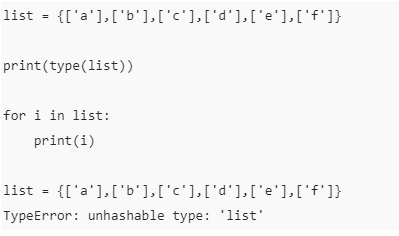
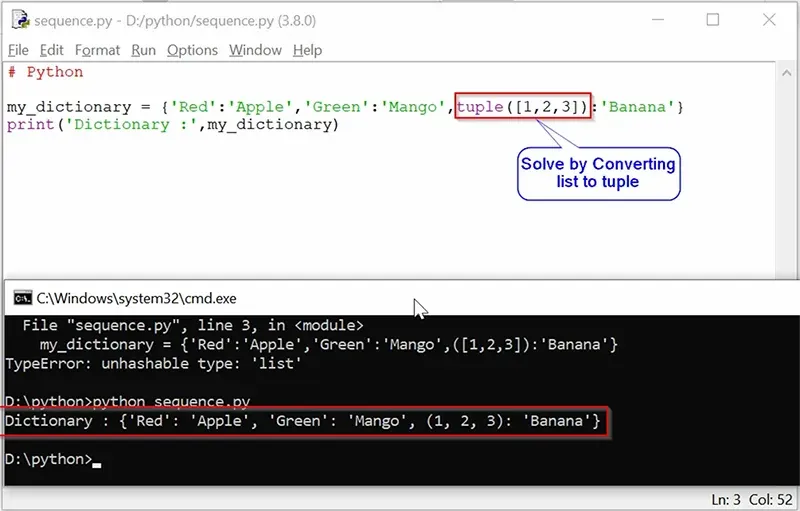


![Typeerror: unhashable type: 'dataframe' [SOLVED] Typeerror: Unhashable Type: 'Dataframe' [Solved]](https://itsourcecode.com/wp-content/uploads/2023/04/Typeerror-unhashable-type-dataframe.png)


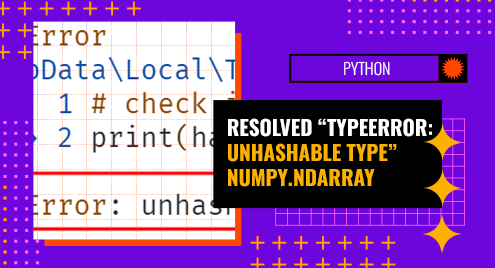






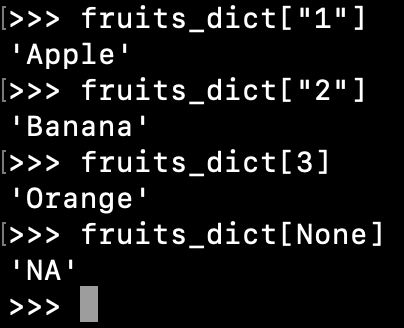




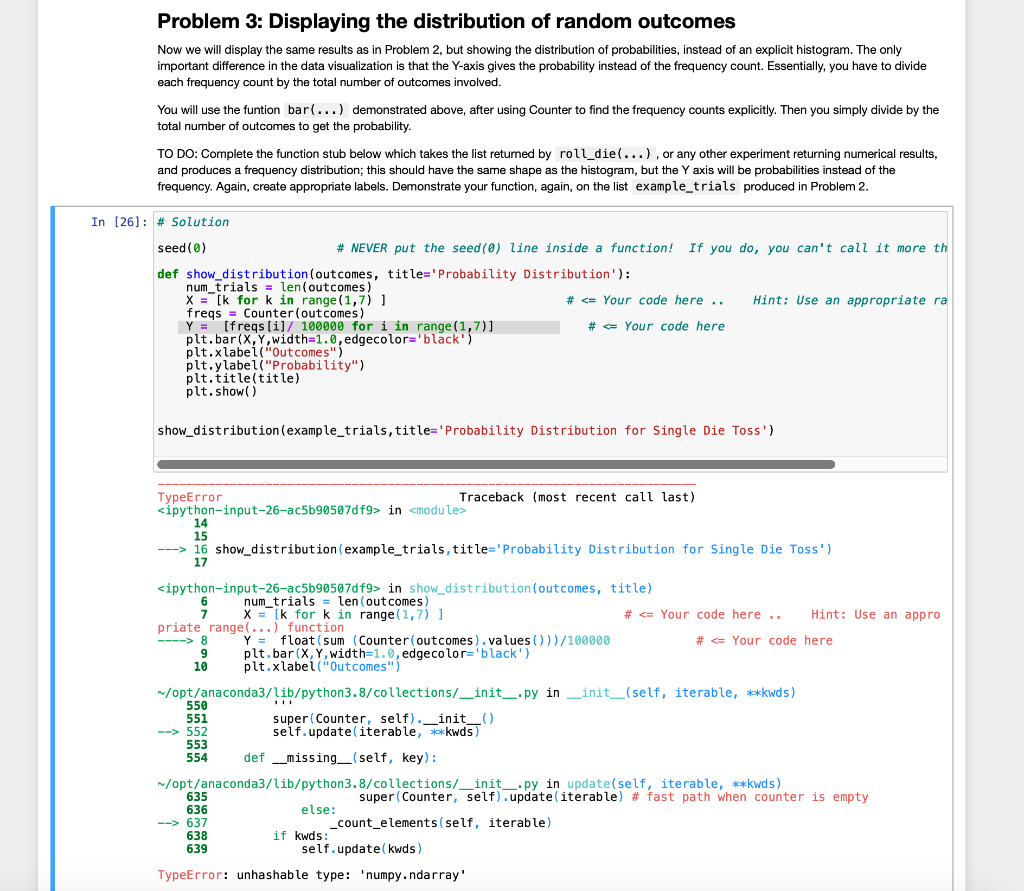











Article link: typeerror: unhashable type: dict.
Learn more about the topic typeerror: unhashable type: dict.
- TypeError: unhashable type: ‘dict’ – python – Stack Overflow
- TypeError: unhashable type: ‘dict’ in Python [Solved]
- How to Handle TypeError: Unhashable Type ‘Dict’ Exception …
- TypeError unhashable type ‘dict’ – STechies
- TypeError: unhashable type: ‘dict’ – Discussions on Python.org
- Python TypeError: unhashable type: ‘dict’ Solution
- How to fix TypeError: unhashable type: ‘dict’ – sebhastian
- TypeError: unhashable type: ‘dict’ in Python (Fixed)
- Unhashable Type “dict’ – Linux Hint
- How to Fix – TypeError unhashable type ‘dict’
See more: nhanvietluanvan.com/luat-hoc